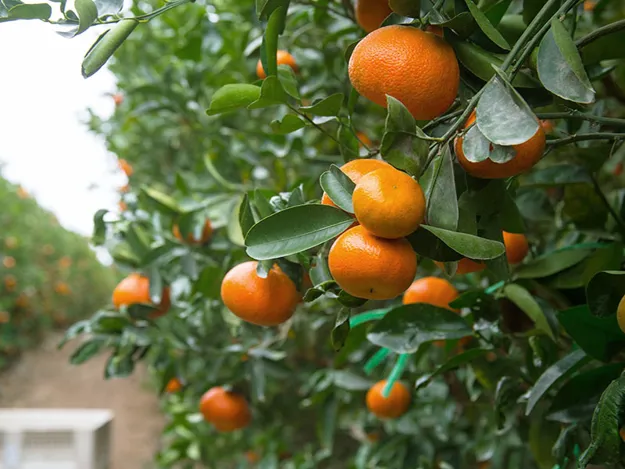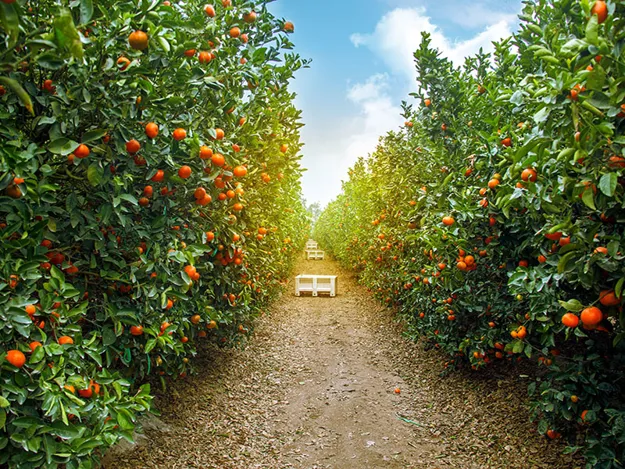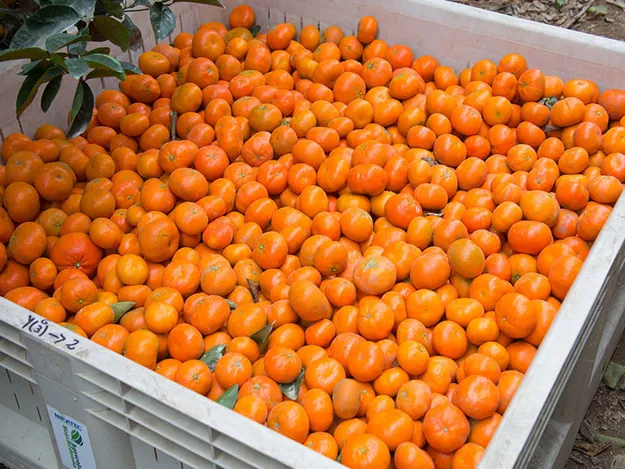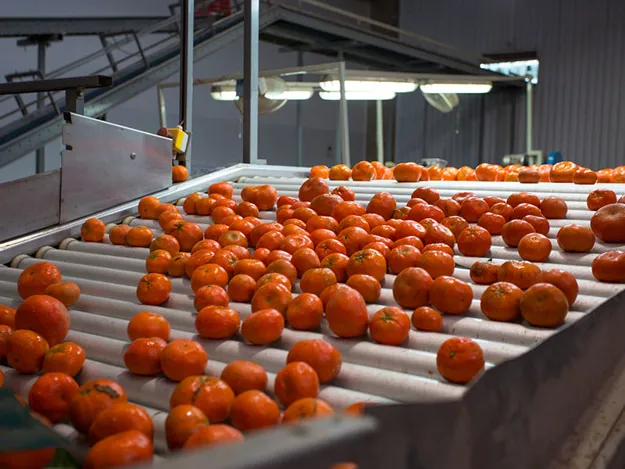While Peruvian mandarin shipments to overseas destinations doubled from 20,000 tons in 2005 to 40,000 tons in 2013, exports truly picked up pace in the following eight years, reaching 200,000 tons by 2020. "The reason for this impressive growth was the introduction of modern easy peelers varieties, particularly the Nadorcott and Tango," says Alfonso Rizo-Patrón, a member of Procitrus, the Association of Citrus Producers of Peru, and vice president of CPF, the Fruit Producers Consortium S.A.

However, as Alfonso Rizo-Patrón recalls, the beginnings of Peru's citrus exports date back to the '90s, when "we started exporting limited quantities of table oranges, mainly of the Washington Navel variety. The quality was excellent, but the Citrus Tristeza Virus (CTV) arrived and wiped almost everything out. And when the European market later opened up for Peruvian citrus, Peru started exporting mainly Satsuma mandarins."
"At that time, the government promoted the development of the fruit and vegetable sector, not only for international marketing, but also to facilitate the supply of Peruvian fruits and vegetables to the domestic market, and this attracted many investors, also to the citrus sector. Indeed, in the early 2000s, there was a very significant growth of the acreage planted with citrus. In 2009, when I joined the sector, I remember that very high-quality Satsuma mandarins were being exported to the United Kingdom and the Netherlands, but it was not until a producer started cultivating the W. Murcott variety that everything changed. In just over ten years, about 6,000 hectares were planted with W. Murcott and Tango. Meanwhile, many plots of Satsuma mandarins, whose productions today are mostly intended for the domestic market, the United Kingdom and Canada, have been replaced by Nadorcott and Tango."

According to the Procitrus representative, Peru currently has around 80,000 hectares devoted to citrus cultivation, including mandarins (about 17,000 hectares), oranges (mainly for juicing) (about 30,000 hectares), limes and lemons (about 25,000 hectares), as well as grapefruits. Procitrus has 148 members with about 9,000 hectares planted with mandarins, which is about 60% of Peru's total acreage. These producers also account for 85% of the country's mandarin exports. "The members are mainly located in the central and southern parts of Peru, but there is also cultivation in the jungle, although this supply is mostly intended for the domestic market. The association's focus is not only on boosting exports and opening new markets, but also on promoting technical-productive improvements through the provision of inputs and advisory services to its members, thus helping introduce technologies and knowledge."
Procitrus imports fertilizers and phytosanitary products, among other things, at favorable prices from the EU, China and the U.S. "We also organize study trips to mandarin-producing countries such as Morocco, Spain, South Africa and the United States. And when associated exporters express their interest in gaining access to a certain foreign market, the association establishes contacts with the competent government departments and with SENASA, the National Agricultural Health Service, to open negotiations with those markets. In fact, it was Procitrus that insisted on opening the markets of the United States, China and recently also Japan to Peruvian citrus. And as surprising as it may seem, Japan opened its market to the Satsuma, a mandarin originally from this country. Negotiations are carried out per tariff item, and not necessarily per crop, and the citrus sector has several tariff items. However, in the near future, we hope to start negotiations to be able to ship our Nadorcott and Tango mandarins to the Japanese market."

Procitrus provides a service to its members not only in terms of marketing; it also trains them to ensure they will supply products with the right size, skin color or Brix degrees, based on the demands of each destination market. "When we started exporting Nadorcott mandarins, the Brix value ranged between 9 and 9.5 degrees, partly due to the generally high temperatures in Peru. Nowadays, thanks to the knowledge acquired in other producing countries and transferred to our producers, we are able to supply the fruit with a Brix of between 10.5 and 12 degrees; an indispensable requirement if you want to be successful in the international market. Although obtaining mandarins with the right skin coloration might be difficult in Peru, thanks to the advice and technology obtained through Procitrus, we have been able to achieve very high standards when it comes to external quality," says Alfonso Rizo-Patrón.
The marketing window goes from June to September, when the mandarin production ends in the Northern Hemisphere, and this has allowed Procitrus to consolidate itself in the American and European markets with the Nadorcott and Tango varieties. "8 years ago, only 10% of citrus sales in the EU occurred within our window; now that percentage has risen to 30-35%. Also, in the past, citrus sales in the United States were five times greater in winter than in summer, but currently this figure has dropped to 1.5. This change in consumer behavior should certainly facilitate the marketing of our modern easy peeler varieties, but there is no doubt that the extraordinary quality of these varieties has already largely motivated this development. Today, supermarkets in the Northern Hemisphere can fill their shelves with Nadorcott and Tango mandarins from December to June with local productions, and from June to November with productions from the Southern Hemisphere. Peru delivers its first Nadorcott volumes to the market in June. The next to arrive are South Africa and Chile, our biggest competitors, which start delivering their fruit in July and August, respectively."

Despite the good prospects for the sale of high-quality easy peelers, there are currently no major projects to expand the mandarin acreage in Peru. "Most large-scale investment is going to the development of avocado and blueberry plantations in the north of the country. However, in Arequipa, in the south of Peru, there are currently plans for the construction of a tunnel through the mountains to make it possible to bring water from a reservoir located on the eastern slope, where it rains a lot, to the western flank, where the climate, although much drier than on the other side, is ideal for fruit production. There are plans to devote some 40,000 hectares to fruit cultivation at an altitude of 1,500 meters above sea level, mostly for the production of avocados and blueberries, but the weather conditions would also be highly suitable for the cultivation of mandarins," says Alfonso Rizo-Patrón.
As for the other citrus fruits grown in Peru, Alfonso says that most of the oranges are for juicing, while grapefruit production is not very large and is mainly intended for the domestic market. "And then we also have limes, which are widely used in Peruvian cuisine."
Lime cultivation is mainly carried out in the north of the country, where there are some producers with farms of up to 1,000 or 1,500 hectares. The most important exports of other citrus fruits are of Tahiti lime, whose acreage has increased significantly in recent years."
While Europe remains a very attractive market for Peru, especially thanks to manageable logistics, with a transit time of 15 to 22 days by sea, the Chinese market is perceived as a new destination with great potential, since the transit time of maritime transport will be reduced from 35-40 days to 23-25 days once the route to the new port of Shanghai from the port of Chancay becomes operational. "Until now, the Far East didn't seem a very attractive option for us due to long transit times, especially if cold treatment is necessary, which is the case for shipments to several countries in Asia. The fruit can be severely affected if stored at zero degrees for 35 days. For Satsuma exports to Japan, however, the problems that may arise from cold treatment have been somewhat diminished, since we have managed, in consultation with the Japanese authorities, to establish a temperature a couple of degrees higher. Although this system requires 7 more days of cold treatment, it matches perfectly with the duration of the trip to Japan (23 days). In the not too distant future, we also hope for the Government to reach an agreement with Japan for the export of Nadorcott and Tango," says Alfonso.

For more information:
Alfonso Rizo-Patrón Ruiz de Somocurcio
CPF (Fruit Producers Consortium S.A.)
Av. Nicolas Arriola 314, Of. 703
Lima, Peru
Tel.: +511 475 9999
Email: [email protected]
www.cpf.com.pe
